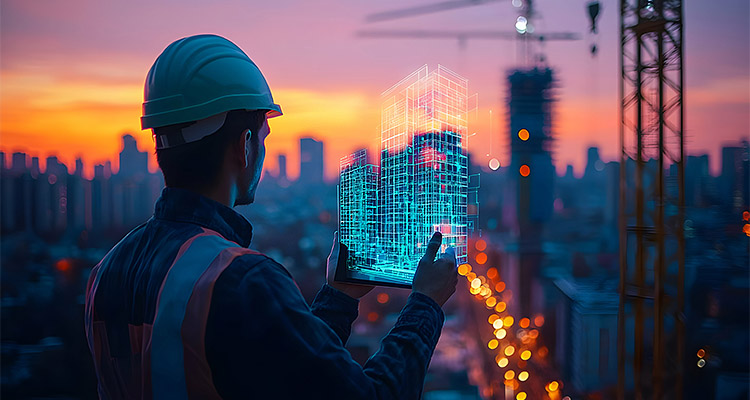
Digital twins in construction and civil engineering
The intersection of construction, civil engineering and digitalisation is a perfect commercial storm.
Construction is simultaneously one of the largest sectors in the world and globally, by 2030, construction output is expected to grow by 85 per cent to a $15.5 trillion market. To bring that closer to home, the UK construction market is projected to be worth £481.34 billion by 2030.
Globally, civil engineering was valued at around $12.5 trillion in 2023 – with anticipated growth of around five per cent each year until 2032.
At the same time, construction and civil engineering remain amongst the least digitised sectors.
Estimates of the potential savings following digitalisation range from 13-to-21-per cent throughout the design, engineering, and construction phases. Sources identify a further ten-to-17 per cent throughout the operation of a given building or project.
In the UK, where building costs are set to rise 17 per cent over the next five years, these potential savings have led to intense interest in a range of digital technologies, and digital twin technology has emerged as a clear leader in these considerations.
What is a digital twin?
A digital twin is a digital, or virtual representation of a real-world object. The idea is not new; the first digital twin dates to 1970.
More recently, 2023 data from McKinsey shows that in advanced industries, almost 75 per cent of companies have already adopted digital twin technologies that have achieved (at least) a medium level of complexity.
Even within construction, there are well-established digital twin examples. 2022 saw the city of Los Angeles create a digital twin of seven blocks within the Bunker Hill neighbourhood to drive decarbonisation initiatives.
Such environmental considerations are one of the main drivers for the primacy of digital twins when it comes to the impact of technology on construction, but they are far from the only benefit.
Why use digital twins?

One of the earliest benefits of a digital twin is that it enables a ‘what if’ approach, which combines sensor-based data and predictive analytics to explore options to optimise the design of the building. This means that before ground is struck, the building has evolved (albeit digitally).
Using augmented reality to then support the construction ensures accuracy to these plans and quality control.
Digital twins also then assist throughout construction and early operation, primarily by helping with more accurate component management and supply chain optimisation. The ‘twin’ integrates data from sources including sensors on materials and equipment, and feeds this into progress tracking software.
This provides a single, up-to-date view of all components for the building or project. This includes location, status, and specification. Real-time visibility prevents loss, and ensures the right components are available when and where needed.
There is a rapid financial benefit here as an accurate picture of the quantity and location of each component means that an organisation can minimise both overstocking (reducing waste and storage costs) and understocking (preventing project delays).
Moving into the early operation of a building, these ‘what if’ scenarios can be refocused onto proactive fault detection.
Running advanced analytics and even AI against the data from a building can identify subtle anomalies or deviations from normal operating parameters before they escalate into actual faults or failures. In the case of expensive buildings or civil engineering projects, such early notice can be worth millions.
As the operation of the building (and its digital twin) matures, eliminating the cost and management of doing routine visits for perfectly functioning equipment often surprises most organisations. Increased accuracy of the sensors that feed the virtual model, combined with intelligent planning software, mean that visits can be aligned with preventing damage to assets or components, rather than replacing them, when broken.
The net result is that the maintenance programme makes fewer visits, but those that are made are far more impactful in terms of cost savings to the business and improvements to environmental sustainability.
The ultimate goal of digital twins
The objective of a digital twin is to enable the exploration and automation of the full lifecycle of the building and its environmental and operational considerations – without having to learn via trial and error in the real world.
As data is fed from design, operations, maintenance and other stakeholders, the digital twin becomes the reference for any proposed changes. From a management perspective, this is invaluable as it both assists the integration around ‘digital hand-offs’ between parties (i.e. whose technology covers what) and provides clear transparency on segregation of duties (who is responsible for what).
The goal is the development of truly smart buildings: capable of not only monitoring themselves but also understanding maintenance cycles and the parameters for initiating actions.
These benefits are critically dependent on – and subject to – accurate, current data on all components. The axiom of ‘rubbish in, rubbish out’ is particularly applicable to digital twins.
The data for digital twins
For large scale construction and civil engineering projects getting good input data requires significant investment and effort. The optimal use of digital twins often requires an extensive array of IoT technologies and sensors across the construction to monitor conditions, tolerances, and changes.
Because any given construction or civil engineering project involves so many stakeholders, using disparate software, formats, and platforms, one of the main challenges is to overcome the inevitable data silos, where valuable information remains isolated and inaccessible to other parties. As a result, interoperability is now a major focus for digital twins in construction. Implementing compatible data formats and standardised protocols is often a critical concern.
However, given the massive potential savings to be gleaned from successful digital twin projects, these barriers are quickly being tackled. Those who successfully navigate this perfect storm will emerge as leaders in a market set to be worth $184.5 billion by the end of the decade.
For a list of the sources used in this article, please contact the editor.
Jaco Vermuelen is CTO at BML Global. As a digital transformation partner for a wide array of projects, spanning construction and civil engineering in education, healthcare and utilities verticals, BML Global has helped organisations realise these benefits in record time.